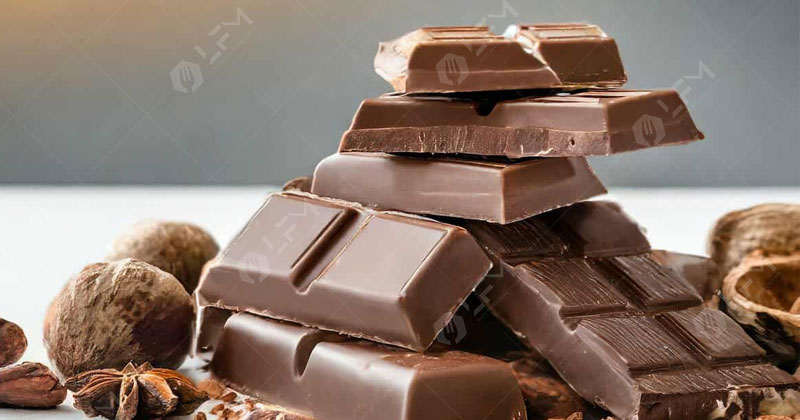In the production process of chocolate, the choice of machines is crucial to the quality of chocolate products, production efficiency and profitability of the factory. Modern chocolate factories usually use a series of specialized machines, from the processing of cocoa beans to the packaging of the final chocolate products, each link has corresponding machines and equipment to complete. The following are the main machines commonly used in chocolate factories and their functions.

1. Cocoa bean cleaning equipment
Chocolate production begins with the processing of cocoa beans. In order to ensure the quality of chocolate, impurities such as dust, stones, and leaves in cocoa beans must be removed first. Common equipment includes vibrating screens, wind separators, and magnetic separators. Vibrating screens are used to screen out large particles of impurities, wind separators blow away light impurities through airflow, and magnetic separators are used to remove metal particles that may be mixed in.
2. Cocoa bean roasters
After the cocoa beans are cleaned, they need to be roasted. Roasting is an important step in enhancing the flavor of chocolate, and the control of different temperatures and times will affect the final taste of chocolate. Industrial chocolate factories usually use continuous roasters or drum roasters, which can accurately control the temperature and time of roasting to ensure that the cocoa beans are evenly heated.
3. Cocoa bean shell separator
After roasting, the shells of the cocoa beans need to be removed to obtain the core part of the cocoa beans – the cocoa kernel. This step uses a shell separator to separate the shell from the cocoa kernel through physical collision and airflow.
4. Cocoa grinder machine
After separation, the cocoa kernel enters the grinding stage and is ground into cocoa liquor. The cocoa grinder releases the oil (cocoa butter) in the cocoa kernel through strong mechanical force to form cocoa liquor. Commonly used industrial equipment includes ball mills and five-roller grinders, which can grind the cocoa kernels to a very fine degree to ensure that the final chocolate has a delicate and smooth taste.
5. Mixer machine
In chocolate production, in addition to cocoa liquor, ingredients such as sugar, milk powder, and emulsifiers also need to be mixed evenly with the cocoa liquor. The mixer effectively mixes these ingredients with the cocoa liquor to ensure that the finished chocolate has a uniform composition. This process is usually done using a twin-shaft mixer or a vertical mixer.
6. Chocolate conching machine
After the chocolate mixture passes through the mixer, it needs to be further refined to make the chocolate smoother. This step is usually done using a chocolate conch or a five-roller mill to grind the chocolate mixture to a finer particle size until its particle fineness reaches about 20 microns to ensure the chocolate melts in your mouth.
7. Chocolate tempering machine
Tempering is a key step in chocolate production and directly affects the final texture and gloss of the chocolate. The tempering machine heats the chocolate mixture, cools it, and then reheats it to a specific temperature to ensure that the cocoa butter crystal structure in the chocolate is stable, thus avoiding the phenomenon of white bloom. The tempering machine is one of the essential equipment in most modern chocolate factories.
8. Chocolate pouring and molding equipment
After tempering, the chocolate needs to be poured into molds to form. Pouring equipment can automatically pour tempered chocolate liquid into pre-designed molds to form chocolate bars, chocolate blocks or other shapes. Factories usually use automatic pouring machines, which can quickly complete the molding of large quantities of chocolate in a short time.
9. Chocolate cooling tunnel
The poured chocolate needs to pass through the cooling tunnel to cool and solidify. The cooling tunnel can control the cooling rate of the chocolate to ensure that the chocolate maintains its gloss during the cooling process and avoid cracks or bubbles. The length and temperature control of the cooling tunnel can be adjusted according to the requirements of the production line.
10. Chocolate packaging equipment
After the chocolate is cooled, it enters the packaging stage. Automatic packaging machines can efficiently complete the packaging of chocolate, including wrapping, sealing, labeling and other processes. Some factories also use packaging equipment with quality inspection functions to ensure that the appearance and weight of each piece of chocolate meet the standards.
Conclusion
The chocolate factory has a variety of machines, and each production link is inseparable from efficient mechanical equipment. With the technological advancement of the chocolate industry, these equipment are constantly updated to improve production efficiency and product quality. Understanding and mastering the functions and operations of these equipment can not only help factories produce high-quality chocolate products, but also reduce production costs and enhance market competitiveness.
